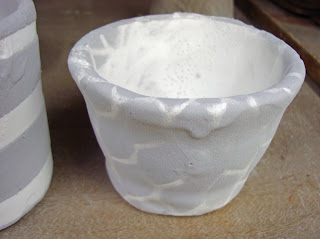

Glazed Bowls. Good white dipped glaze from 1st batch of white glaze. Bleeding blue 2nd glaze. too thick? May not have bound to 1st layer/left to dry too long?
1st Year BA(Hons)Ceramics, Cardiff School of Art.










This term has been about experiencing new ceramic processes and coming up with new ideas. I think I have achieved ideas more than outcomes. The execution of my ideas has not always been as successful as hoped, but I have gained a foundation to build on for future endeavours. I will also learn from mistakes, I feel at present only acquainted with clay but look forward to becoming at ease and enjoying clay more. Once I have more knowledge and understating of clay science and glaze magic.


 This is my first attempt at glazing. As the whole of the 1st year descended on the glaze room at the same time it was chaotic. I found it hard to work with the mess and commotion. I dipped the thrown bowls in white glaze and left to dry. I then brush painted a design onto one bowl and used a squirty bottle to create drips down the sides of the other thrown bowl. I used blue and white glaze for the bowls. The thrown pots were also dipped in the white glaze I then tried spraying green glaze onto the white. I used a shoe lace to create a design on one pot and some packing as a stencil for the second pot. The smaller column pot I tried spraying red glaze at different ranges around the pot to create different effects with the glaze (thick drippy/thin faint). I don't know how well these pots/bowls will turn out. I think some of the glaze is applied to thickly. I dipped the slip cast caterpillar in the white glaze.
This is my first attempt at glazing. As the whole of the 1st year descended on the glaze room at the same time it was chaotic. I found it hard to work with the mess and commotion. I dipped the thrown bowls in white glaze and left to dry. I then brush painted a design onto one bowl and used a squirty bottle to create drips down the sides of the other thrown bowl. I used blue and white glaze for the bowls. The thrown pots were also dipped in the white glaze I then tried spraying green glaze onto the white. I used a shoe lace to create a design on one pot and some packing as a stencil for the second pot. The smaller column pot I tried spraying red glaze at different ranges around the pot to create different effects with the glaze (thick drippy/thin faint). I don't know how well these pots/bowls will turn out. I think some of the glaze is applied to thickly. I dipped the slip cast caterpillar in the white glaze. 








The marks made can easily be identified as belonging to each participating person. I noticed my marks are very heavy, use simple shapes and stand-out from the jumble of the picture. I do enjoy geometric minimalist art and abstract expressionism. I interested in pure form and pure line. Follow link Minus Space.


Two margarita glasses have been joined together, I used ash white slip to ‘glue’ the pieces together leaving one glass in the mould and propping the other glass up with a plastic triangle until the slip set. The shape is simple and pure, I had planned on adding cogs to the ends but this didn’t look quite right. I would need to experiment with different sizes of cog and maybe different mechanical inspired shapes which would require more moulds and more time. The form itself is pleasing, the balance and line is good.
The Dust-Buster piece was less successful the concertinaed plastic created lots of air bubbles in the plaster. The shape and detail came out but not as sharply as I would have liked.
 Just to make use of the mould I added the cast of the wooden sock darning object. It is a cross of old and new household inventions. I put the two things together as the scale and flow worked quite well also.
Just to make use of the mould I added the cast of the wooden sock darning object. It is a cross of old and new household inventions. I put the two things together as the scale and flow worked quite well also.
If you only have one mould it becomes a waiting game, I needed two margarita glass moulds to construct my proposed shape. I also need a few cog moulds, and I could only do one at a time! I realize now that mould making and casting takes 4 times as long as you anticipate, and time management is crucial! If I had more time and the foresight to plan I feel I could create some very interesting shapes and ideas. The margarita mould and the cog mould were very successful and I am glad the effort in producing them paid off.